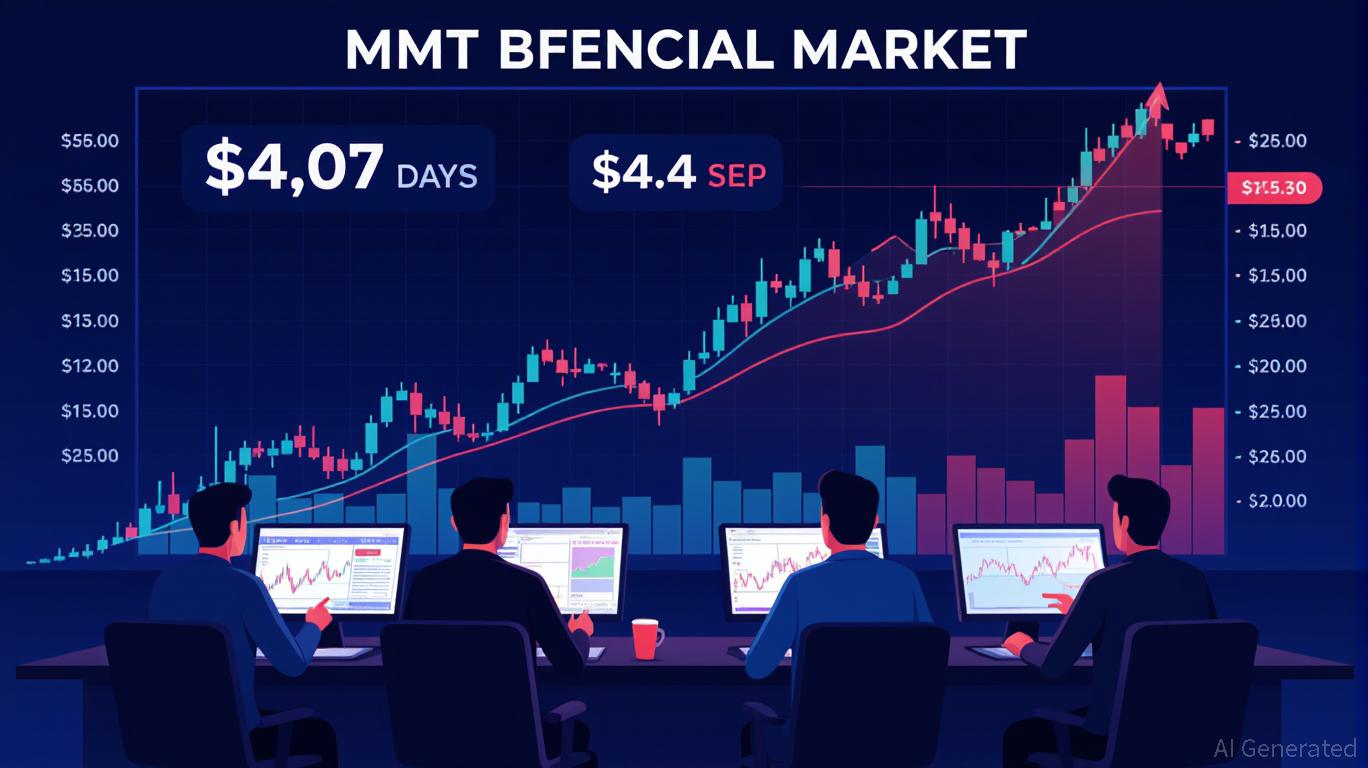The Growing Buzz Around Momentum (MMT): Could This Be the Next Big Thing in Crypto?
- Momentum (MMT) surged to $5.18B market cap after Binance's oversubscribed Prime Sale and explosive listing price spikes. - Built on Sui blockchain, MMT's ve(3,3) liquidity model and CLMM architecture aim to optimize DeFi capital efficiency and trading. - Institutional tools like MSafe and RWA integration via Momentum X address DeFi's security and compliance challenges. - Extreme volatility and speculative trading raise sustainability concerns despite Binance's airdrop-driven network effects.
Market Sentiment: Demand and Volatility Collide
Momentum’s recent performance has been remarkable. This overwhelming interest highlighted strong investor belief in MMT’s prospects, especially with Binance’s backing through its Seed + Label initiative.
The excitement persisted on November 4, when MMT debuted on Binance. Within mere hours, the token soared almost 800%, reaching a peak of $0.8859, according to a
Binance’s airdrop campaign has further fueled this short-term enthusiasm. Eligible participants received 7.5 million MMT tokens, encouraging both engagement and liquidity, as reported by a

Technical Foundation: Ecosystem Powered by Ve(3,3)
Looking past the buzz, MMT’s underlying technology sets it apart as a serious player in DeFi. Built on the Sui blockchain, the platform utilizes Sui’s high-speed infrastructure to implement a concentrated liquidity market maker (CLMM) system. This approach lets liquidity providers focus their capital within chosen price bands, boosting efficiency and minimizing slippage for traders, as described in a
Central to MMT’s design is its ve(3,3) liquidity mechanism, which draws inspiration from Curve Finance’s governance model. By locking up MMT tokens, users receive vMMT (vote-escrowed MMT), granting them the ability to vote on where protocol rewards are directed, typically toward the most lucrative liquidity pools. This structure aligns the interests of liquidity providers, traders, and holders, ensuring capital is allocated efficiently, as outlined in a
Sui’s Programmable Transaction Blocks (PTB) further improve the user experience by allowing complex actions—such as swapping tokens and claiming rewards—to be completed in a single transaction, lowering gas fees and streamlining use, as mentioned in a
To attract institutional users, MMT offers MSafe, a multi-signature wallet designed for Move-based blockchains, and Momentum X, a compliance solution for integrating real-world assets (RWAs). These features address major DeFi challenges such as security and regulatory requirements, as highlighted in a
Is MMT a Game-Changer or Just a Passing Trend?
The blend of advanced technical features and intense market enthusiasm indicates that MMT could be more than a temporary phenomenon. Its ve(3,3) model and Sui-based decentralized exchange provide scalable, accessible solutions to DeFi’s liquidity issues, while Binance’s airdrop has amplified its reach. Still, the token’s sharp price swings and heavy reliance on speculation raise concerns about its long-term prospects.
For MMT to sustain its momentum, it will need to show steady on-chain engagement and practical adoption that goes beyond the initial airdrop excitement. The rollout of RWAs through Momentum X and the platform’s AI-powered liquidity routing are encouraging developments, but only time will reveal if these innovations lead to lasting value.
Conclusion
Momentum (MMT) has quickly become a focal point in the crypto sector, combining technical advancements with strong market momentum. While its recent price surges reflect speculative interest, the platform’s foundation—built on Sui’s scalability and the ve(3,3) model—offers real potential for disruption. Investors should keep an eye on blockchain activity, institutional uptake, and regulatory shifts to determine whether MMT’s rise marks a new era or is simply a brief surge.
Disclaimer: The content of this article solely reflects the author's opinion and does not represent the platform in any capacity. This article is not intended to serve as a reference for making investment decisions.
You may also like
Trust Wallet Token (TWT) Price Forecast: Ushering in a New Chapter for Decentralized Finance?
- Trust Wallet Token (TWT) surged to $1.6 in October 2025, doubling from June lows, driven by strategic integrations and institutional partnerships. - TWT's reimagined utility model, including Trust Premium loyalty rewards and Onramper fiat-onboarding, boosted real-world adoption in emerging markets. - Institutional interest grew via RWA tokenization (e.g., U.S. Treasury bonds) and ZKsync privacy integrations, while Q3 2025 data showed $330M market cap and $11M daily volume. - Analysts project $5.13 (2025)

HBAR's ETF Surge Contrasts with Institutional Sell-Off as Token Drops 2.1%
- HBAR fell 2.1% to $0.1837 as a 95% volume surge signaled institutional selling pressure, breaking key resistance near $0.1940. - Canary Capital's first U.S. HBAR ETF (HBR) launched October 28, 2025, aiming to boost institutional access despite recent price weakness. - Technical indicators show bearish structure with critical support at $0.1831, suggesting further downside risk if consolidation fails. - While Hedera's enterprise blockchain infrastructure remains stable, macroeconomic pressures and regulat

Buffett Prefers Entrusting His Wealth to Family Rather Than Directing Philanthropy After His Passing
- Warren Buffett accelerates $150B estate distribution via family foundations, allocating $500M annually to four charities. - Shifts from Giving Pledge model to direct family stewardship, donating 2.7M Berkshire shares worth $1.35B to children's foundations. - Retirement as Berkshire CEO in 2025 and admission of past philanthropy's "infeasibility" highlight pragmatic approach to wealth transfer. - Strategy reflects broader trend toward decentralized giving, challenging traditional pledge frameworks with 9/
Ethereum Updates: $36B DeFi Outflow Highlights Security and Governance Issues Threatening Ethereum
- DeFi's total value locked (TVL) fell $36B in weeks, with Ethereum losing 13% to $74.2B amid security breaches and waning institutional interest. - High-profile exploits like Balancer's $120M hack exposed DeFi vulnerabilities, while Ethereum's price languished near $3,600 with $2,600 support at risk. - Positive signals include Tron's Justin Sun staking $154M ETH and Lido DAO's $10M token buyback, reflecting growing staking demand and confidence. - Analysts predict Ethereum could break out in 2026 due to r
